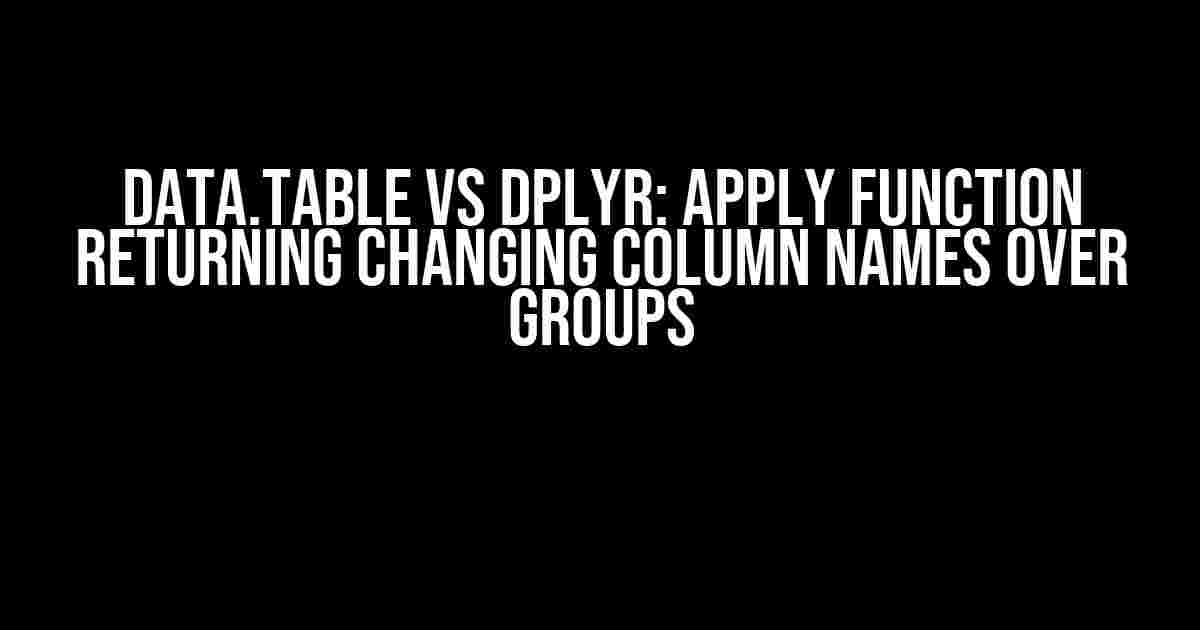Are you tired of writing tedious and inefficient code to manipulate your data in R? Do you struggle with applying functions to changing column names over groups? Look no further! In this article, we’ll dive into the world of data manipulation using two of the most popular packages in R: data.table and dplyr. We’ll explore how to use the apply function to return changing column names over groups, and which package reigns supreme in this regard.
The Problem: Applying Functions to Changing Column Names Over Groups
Imagine you have a dataset with multiple columns and groups, and you want to apply a function to each group that returns a new column with a dynamic name. For example, let’s say you have a dataset of sales data with columns for region, product, and sales amount:
region product salesAmount
1 North A 100
2 North B 200
3 South A 50
4 South B 150
5 East A 200
6 East B 300
You want to calculate the total sales for each region and product, and then create a new column with the result, but with a dynamic name based on the group. For instance, you might want to name the new column “salesTotal_Region” or “salesTotal_Product”. This is where the apply function comes in.
Data.Table Solution: Using the .SD and .GRP Combinations
Data.table is a powerful package in R that provides an efficient way to work with large datasets. One of the most useful features of data.table is the .SD and .GRP combinations, which allow you to apply functions to groups and dynamically create new columns.
Here’s an example of how you can use data.table to solve our problem:
library(data.table)
# Create a sample dataset
dt <- data.table(region = c("North", "North", "South", "South", "East", "East"),
product = c("A", "B", "A", "B", "A", "B"),
salesAmount = c(100, 200, 50, 150, 200, 300))
# Set the key for the data.table
setkey(dt, region, product)
# Use .SD and .GRP to apply the function and create a new column
dt[, salesTotal := sum(salesAmount), by = .GRP]
# Print the result
dt
This code creates a new column called "salesTotal" that contains the total sales for each region and product. The .SD and .GRP combinations allow us to apply the sum function to each group and dynamically create the new column.
Pros and Cons of the Data.Table Solution
The data.table solution has several advantages:
- Efficient: Data.table is highly optimized for speed and efficiency, making it ideal for large datasets.
- Flexible: The .SD and .GRP combinations provide a flexible way to apply functions to groups and dynamically create new columns.
- Concise: The code is concise and easy to read, making it perfect for quick data manipulation tasks.
However, there are some disadvantages to consider:
- Steep learning curve: Data.table has a unique syntax and requires some practice to get used to.
- Limited data manipulation capabilities: While data.table is excellent for fast aggregation and grouping, it's not as versatile as dplyr for more complex data manipulation tasks.
Dplyr Solution: Using the Group_By and Mutate Functions
Dplyr is another popular package in R that provides a grammar-based approach to data manipulation. It's known for its simplicity and flexibility, making it a great choice for data analysis tasks.
Here's an example of how you can use dplyr to solve our problem:
library(dplyr)
# Create a sample dataset
df <- data.frame(region = c("North", "North", "South", "South", "East", "East"),
product = c("A", "B", "A", "B", "A", "B"),
salesAmount = c(100, 200, 50, 150, 200, 300))
# Use group_by and mutate to apply the function and create a new column
df %>%
group_by(region, product) %>%
mutate(salesTotal = sum(salesAmount))
# Print the result
df
This code creates a new column called "salesTotal" that contains the total sales for each region and product. The group_by and mutate functions allow us to apply the sum function to each group and dynamically create the new column.
Pros and Cons of the Dplyr Solution
The dplyr solution has several advantages:
- Easy to learn: Dplyr has a simple and intuitive syntax, making it easy to pick up for beginners.
- Versatile: Dplyr provides a wide range of data manipulation capabilities, including filtering, sorting, and merging datasets.
- Consistent: Dplyr's grammar-based approach ensures consistency across different data manipulation tasks.
However, there are some disadvantages to consider:
- Slower: Dplyr can be slower than data.table for large datasets, especially when it comes to aggregation and grouping.
- Less flexible: While dplyr is versatile, it's not as flexible as data.table when it comes to applying functions to groups and dynamically creating new columns.
Comparison: Data.Table vs Dplyr
So, which package reigns supreme when it comes to applying functions to changing column names over groups?
Data.table is the clear winner when it comes to speed and efficiency. Its .SD and .GRP combinations provide a flexible way to apply functions to groups and dynamically create new columns. However, dplyr's grammar-based approach and versatility make it a great choice for more complex data manipulation tasks.
In the end, the choice between data.table and dplyr depends on your specific needs and preferences. If you need to manipulate large datasets quickly and efficiently, data.table might be the better choice. If you prefer a simpler, more intuitive syntax and a wider range of data manipulation capabilities, dplyr might be the way to go.
| Package | Speed | Flexibility | Versatility |
|---|---|---|---|
| Data.Table | Fast | High | Medium |
| Dplyr | Medium | Medium | High |
Conclusion
In this article, we've explored the world of data manipulation in R using data.table and dplyr. We've seen how to apply functions to changing column names over groups using the apply function, and which package is better suited for this task.
Remember, the key to mastering data manipulation in R is to practice, practice, practice! Try out different packages and techniques to find what works best for you and your specific needs.
Happy coding!
This article is optimized for the keyword "data.table vs dplyr: apply function returning changing column names over groups". If you have any questions or comments, please leave them below!
Related Articles:
- Data Manipulation in R: A Beginner's Guide
- Data.Table vs Dplyr: Which Package is Faster?
- Applying Functions to Groups in R: A Comprehensive Guide
Frequently Asked Question
Get ready to conquer the world of data manipulation with data.table and dplyr! But first, let's tackle some common questions about applying functions with changing column names over groups.
How do I apply a function to multiple columns in a data.table with changing column names over groups?
You can use the `.SD` and `.SDcols` syntax in data.table to apply a function to multiple columns with changing column names over groups. For example, `DT[, lapply(.SD, mean), by="grp", .SDcols=c("col1", "col2")]`. This will apply the `mean` function to columns "col1" and "col2" for each group in the "grp" column.
Can I use dplyr's group_by and summarise to apply a function with changing column names over groups?
Yes, you can! However, you'll need to use the `across` function in dplyr 1.0 or later to specify the columns dynamically. For example, `DT %>% group_by(grp) %>% summarise(across(c(col1, col2), mean))`. This will apply the `mean` function to columns "col1" and "col2" for each group in the "grp" column.
How do I specify multiple functions to apply to different columns in a data.table?
You can use the `lapply` function in data.table to apply multiple functions to different columns. For example, `DT[, c(mean_col1 = lapply(.SD[, "col1", with=FALSE], mean), sum_col2 = lapply(.SD[, "col2", with=FALSE], sum)), by="grp"]`. This will apply the `mean` function to column "col1" and the `sum` function to column "col2" for each group in the "grp" column.
Can I use dplyr's mutate to apply a function with changing column names over groups?
Yes, you can use dplyr's `mutate` function to apply a function with changing column names over groups. For example, `DT %>% group_by(grp) %>% mutate(col1 = mean(col1), col2 = sum(col2))`. This will apply the `mean` function to column "col1" and the `sum` function to column "col2" for each group in the "grp" column. Note that this will overwrite the original columns.
What's the performance difference between data.table and dplyr for applying functions with changing column names over groups?
In general, data.table is faster than dplyr for large datasets, especially when working with grouping and applying functions. However, the performance difference depends on the specific use case, data size, and column types. It's always a good idea to benchmark both options for your specific use case to determine the best approach.


